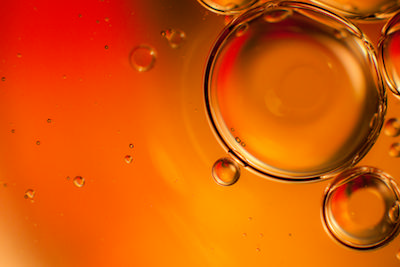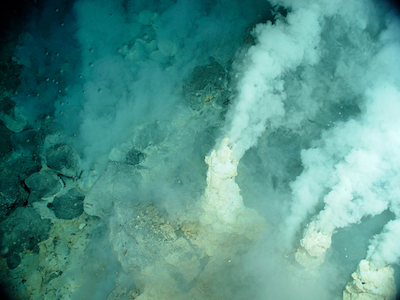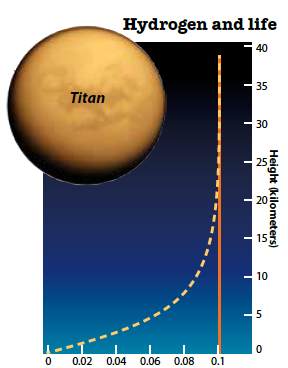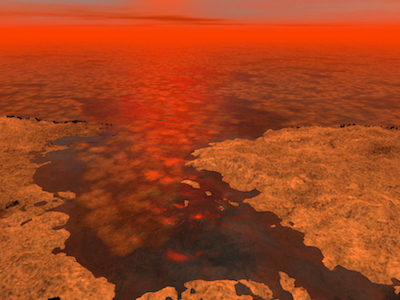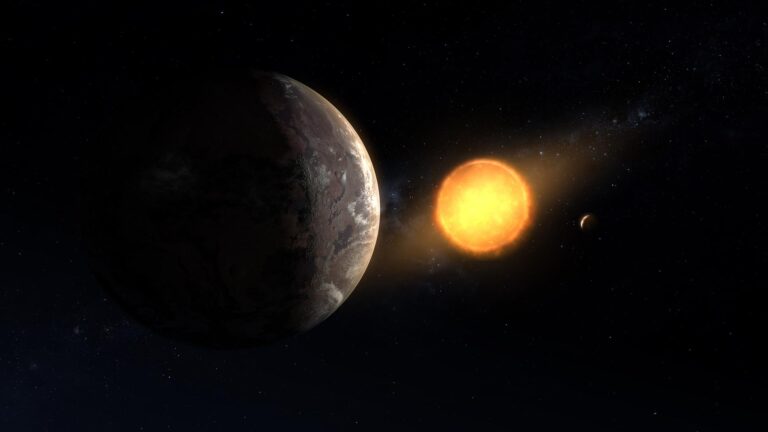Earth is teeming with life — and water makes it all possible. But elsewhere in the cosmos, life might be built from different chemicals that dissolve and assemble in some other liquid: perhaps methane, kerosene, or even chloroform. For now, it’s not feasible for humans to set foot on those worlds and see what’s there, but researchers are exploring some possibilities in labs here on Earth.
The idea of a strange parallel form of life, whose cells do the same basic things as ours using a completely different chemistry, isn’t new to science. Isaac Asimov first broached the subject in his 1962 essay “Not as We Know It: The Chemistry of Life.” And in 2004, the same year the Cassini spacecraft entered Saturn’s orbit, biochemist Steven Benner proposed in a paper in Current Opinion in Biological Chemistry that on a world like Saturn’s moon Titan, life might use liquid hydrocarbons as a solvent (a liquid that can dissolve other substances), the way water is used on Earth.
With new exoplanets joining the roster of known worlds every day, it’s likely that some of them have oceans (or at least warm puddles) of hexane, ethers, chloroform, or other exotic liquids that might serve as the basis for life as we don’t yet know it.
In such alien oceans, the chemistry of life on Earth just wouldn’t work. Water is a polar molecule; its oxygen end has a slight negative charge, while its hydrogen end has a slight positive charge. Those charges affect the kinds of chemical bonds that can happen in water. The structure of molecules like DNA and proteins depends on water’s polar hydrogen bonds.
Most hydrocarbons (compounds made of hydrogen and carbon, such as methane and ethane) are nonpolar — there’s no charge at either end of the molecule. So it’s impossible to form the same kinds of bonds in these chemicals as in water. That’s why if you want to create life in Titan’s methane lakes, you’re going to have use a different set of building blocks altogether.
Chemists and biologists from across the United States — led by organic chemist Paul Bracher at Saint Louis University and funded by a three-year grant from the National Science Foundation — have formed a team to explore what the building blocks of truly alien life might be made of. Using computer simulations and hands-on lab work, they’re exploring how molecules bond in liquid hydrocarbons such as hexane, ethers, and chloroform. Their work falls right on the border between sciences, where chemistry becomes biology.
“It’s like trying to build a car in your backyard out of lawn mower parts, versus having the Maserati factory build a supercar. Life as we know it is the supercar, and we are trying to hack together something that looks like it, out of a different set of parts, to see what we can learn about putting it together,” says Chris Butch of the Earth Life Science Institute. Butch, a computational chemist, will use digital simulations to help understand the details of the chemistry his colleagues will observe in the lab.
If you want life, you’ve got to contain all the chemistry that happens in a cell, separating it from the outside environment. In the cells of every living thing on Earth, oily membranes provide that container. Membranes play an important role in powering the cell’s functions; they’re involved in the chemical reactions that allow plant and animal cells to produce energy. And those chemical reactions depend on the basic fact that the membrane is an oily structure interacting with a watery cell inside of it.
But the team won’t be using methane or ethane, the liquid hydrocarbons that fill Titan’s lakes, for its experiments. Those substances are liquids only when exposed to incredibly cold temperatures like those found on Titan’s surface, not those usually found in chemistry labs on Earth. Instead, the researchers are sticking with hydrocarbons like hexane, which is a good analogue for methane but stays in liquid form at room temperature, as well as chloroform and others. The boundaries of these droplets — where oil meets water — serve as a simple analogue for the early development of cell membranes.
Maurer’s experiments won’t produce anything you could reasonably call a cell membrane, but they just might shed some light on the basic chemistry that can occur at the boundary of oil and water.
“We kind of need this oil phase in our cells to drive energy generation,” says Maurer, “and so it makes sense that you could, in some way, make an oil droplet have functionality that’s similar to an aqueous cell by using the surface of the oil droplet to drive reactions.”
This team isn’t the first to think about the idea of alien cell membranes. In a 2015 Science Advances paper, planetary scientist Jonathan Lunine of Cornell University, working with two chemical engineers (none of the three is involved in Bracher’s project), used digital modeling to determine that vinyl cyanide — a compound made of nitrogen, carbon, and hydrogen, also called acrylonitrile — could theoretically form rudimentary barriers in methane.
However, other molecules might pair with the nucleic acids and help sneak them across the boundary. Biochemical companies have developed molecules called transection agents, which help move nucleic acids through membranes, and one of the team’s goals is to look for combinations of DNA and transection agents that can migrate into the hydrocarbon droplets and remain stable.
“That’s basically saying, ‘Can we tease our biology into functioning at some level in these strange environments?’ ” says Georgia Tech University molecular biologist Loren Williams, who is especially interested in how polymers behave in liquid chloroform.
The team also wants to swap out the nucleic acids’ phosphorus for silicon, creating a molecule that dissolves more easily in hydrocarbons. They also plan to test an alternative genetic molecule using so-called “non-canonical nucleotides,” substituting other chemicals for the familiar adenine, thymine, guanine, and cytosine.
And then there are the really exotic ideas. Bracher’s group at Saint Louis University is working on a completely synthetic molecule that will work like DNA but be made of completely different molecules that form a different type of chemical bond. Instead of the hydrogen bonds that link DNA base pairs, Bracher’s version would use base pairs that share molecules called thioesters.
There’s reason to think it could work. In 2015, Benner, who founded the Foundation for Applied Molecular Evolution in 2001 and is not involved in Bracher’s project, tested a version of DNA with an ether backbone in a solvent of kerosene. He found that this combination wouldn’t work to form life on a place nearly as cold as Titan, but on some so-called “warm Titan” exoplanets, it might be a good option.
“Given how many exoplanets we’re finding around distant stars, chances are there are going to be other worlds like Titan that could have something interesting going on,” says Bracher.
Playing with blocks
From there, one of the next steps is to see how the building blocks of alien life might evolve. Chemistry is subject to natural selection: Systems and structures that are better at replicating themselves tend to outcompete others. That process may be how molecular systems evolve toward greater complexity, eventually producing the specialized systems of molecules and reactions that form cells.
Michael Travisano, an evolutionary biologist with a background in astrophysics, plans to simulate that process on the team’s array of molecules. In this case, selection will be based on whether or not a molecule, or set of molecules, can move back and forth across the barrier between oil and water. The results will tell the team which types of molecular structures or bonds are best suited to the simulated environment. “That’s sort of the stuff of natural selection,” says Travisano.
Maurer is interested in whether the molecules will be able to support basic chemical reactions inside the hydrocarbon droplets. The base pairs in DNA, for example, “recognize” each other by finding which base “fits” well enough to form a bond with another — adenine to thymine and cytosine to guanine. If alternative versions of those molecules can recognize each other and form bonds in other solvents, that’s an encouraging sign that basic biochemistry could be possible in alien seas.
Of course, such a system is not even close to a working cell, and it would still be missing some important building blocks for life. In cells on Earth, proteins called enzymes help reactions happen fast enough to be useful. The team doesn’t have alternative enzymes to go with its membranes and genetic material, though.
“We have backbones we’re making, and we’re going to have base pairs, but the problem is we don’t have an enzyme that will replicate it because the backbone chemistry is not the same,” says Williams. “We really have to start at a more basic chemical level and try to work forward as far as we can.”
Looking for alien life
“A lot of this is going to be exploratory science,” says Butch. “I think it’s a really cool idea for just pushing the boundaries of what our assumptions about the transition from chemistry to biology actually looks like.” In other words, no synthetic alien organism is going to crawl out of the test tube.
“I don’t think that we’re going to discover the origin of life in the next three years or that we’re going to figure out exactly how life could develop [on other worlds] in nonpolar solvents in the next three years,” says Bracher. “What this project is really about is starting to figure out how the rules of the game might change from life as we know it in water to some new form of life that works in oil and nonpolar solvents, whether here on Earth or on distant planets.”
Ice made of hydrocarbons, rather than water, floats on the surface of a lake on Titan in this artist’s concept. Using Cassini data, scientists have confirmed the presence of ethane in lakes on the cloudy moon, which contains the only known surface liquid in the solar system, aside from Earth.
The results could provide useful ideas about not only where, but how to look for life as we don’t know it. For instance, Earth’s atmosphere is rich in oxygen because plants and cyanobacteria release it as a product of photosynthesis. If Bracher and his team can identify potential molecular building blocks for alien cells, they might also be able to predict which chemicals those cells might breathe out into the atmosphere of their home world.
In 2005, astrobiologist Chris McKay worked out how organisms on Titan might metabolize acetylene or ethane, and realized that they’d leave a noticeable signature in Titan’s atmosphere — which, it turns out, may actually be present, though the evidence isn’t yet clear. The Cassini and Huygens probes observed both the lack of an ethane layer around the moon and a lack of acetylene on its surface, though both were expected. The depletion of these substances could be due to a “biological sink” — life consuming them and leading to their absence.
This kind of research can guide how we comb through the reams of data already in hand from missions like Cassini, says Lunine. “No one’s really looked through the data very carefully for them, so one can go back now, seeing that they have these interesting properties, and really try to dig through the data to see if it’s actually there,” he says.
Ultimately, tinkering with alien biochemistry is a step into the unknown, and although the team has some ideas about what to expect, they’re also prepared for surprises along the way.
“My expectation is that a lot of things that we think are challenges to life will turn out to not be, and things we don’t realize are difficulties will all of a sudden [turn out to] be incredibly hard,” says Travisano. “It will be interesting what doesn’t work and what does. Expect surprises.”

